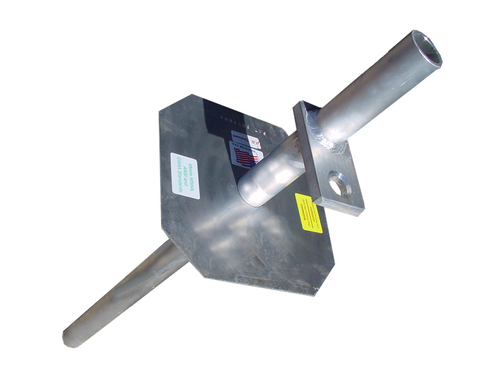
Item # 8619
The Tiedown is made from lightweight aluminum. This tiedown, unlike many others which are equipment mounted, is set into a drill hole. Drill the hole, insert the Tiedown then simply attach the tether of your safety harness and you are ready to work. Since the Tiedown is made completely out of non sparking aluminum it is safe to use around explosives. The entire post is 48" long. 33" of that goes down the hole. There is a 14" plate that sits on top of the ground. Approximately 6" above the plate is the hole where the tether hooks onto. It has been successfully tested by Metallurgical Engineering for durability and will hold 5,000 lbs of pressure. The Tiedown meets ANSI, MSHA and OSHA standards.
IMPORTANT
INSTRUCTIONS AND WARNING INFORMATION FOR THE TIEDOWN
WARNING
A fall could result in serious injury or death. Do not use unless properly trained. Read, understand and follow all instructions. Failure to do so may result in serious injury or death.
Questions? Call 1-888-909-0599
All workers utilizing fall protection must read and understand all information in this brochure. It is the employer's responsibility to ensure that all users are trained in the proper use, inspection and maintenance of fall protection equipment.
General Requirements
* All warnings and instructions must be read and understood before using equipment.
* Equipment must be used by trained personnel only
* All users must understand all OSHA and MSHA regulations. ANSI standards, and other relevant regulations and standards pertaining to fall protection equipment.
* To minimize the potential for accidental disengagement, a competent person must ensure system compatibility.
* All equipment must be visually inspected before each use.
* All equipment should be inspected by a qualified person on a regular basis. Foreman or Supervisor.
* Equipment must not be altered in any way.
* Any product exhibiting deformities, unusual wear, or deterioration must be immediately discarded.
* Employers must provide for prompt rescue in the event of a fall.
* This product is designed for personal fall protection. Never use fall protection equipment for purposes other than those for which it was designed.
* Always check for obstructions below the work area to make sure potential fall path is clear.
Warning
The TIEDOWN should only be used with approved full-body harness and shock-absorbing lanyards.
One person only should be attached to each unit utilized.
INSTRUCTIONS FOR USE
* Drill hole a minimum of 10 feet from face of quarry. Hole size should be between 6 and 10 inches in diameter. Hole should be a minimum of 3 feet in depth.
* Place TIEDOWN into drilled hole. Attach lanyard to the eye of the TIEDOWN by using snaphook on lanyard.
OSHA
1926.S0H b)(l )
"Unprotected sides and edges." Each employee on a walking/working surface (horizontal and vertical surface) with an unprotected side or edge which is 6 feet (1.8 m) or more above a lower level shall be protected from falling by the use of guardrail systems, safety net systems, or personal fall arrest systems.
1926.502(d}
"Personal fall arrest systems." Personal fall arrest systems and their use shall comply with the provisions set forth below. Effective January 1, 1998, body belts are not acceptable as part of a personal fall arrest system. Note: The use of a body belt in a positioning device system is acceptable and is regulated under paragraph (e) of this section.
1926.502(d)(1)
Connectors shall be drop forged, pressed or formed steel, or made of equivalent materials.
1926.502(d)(2)
Connectors shall have a corrosion-resistant finish, and all surfaces and edges shall be smooth to prevent damage to interfacing parts of the system.
1926 .502(d}(3)
Dee-rings and snaphooks shall have a minimum tensile strength of 5,000 pounds (22.2 kN).
1926.502(d)(4)
Dee-rings and snaphooks shall be proof-tested to a minimum tensile load of 3,600 pounds (16 kN) without cracking, breaking , or taking permanent deformat ion .
1926.502(d)(S)
Snaphooks shall be sized to be compatible with the member to which they are connect ed to prevent unintentional disengagement of the snaphook by depression of the snaphook keeper by the connected member, or shall be a locking type snaphook designed and used to prevent disengagement of the snaphook by the contact of the snaphook keeper by the connected member. Effective January 1, 1998,
only locking type snaphooks shall be used.
1926.502(d}{6)
Unless the snaphook is a locking type and designed for the following connections, snaphooks shall not be engaged:
1926.502(d)(6}(i)
directly to webbing, rope or wire rope;
1926.502(d)(6)(ii)
to each other;
1926.502(d)(6)(iii)
to a dee-ring to which another snaphook or other connector is attached;
1926.502(d)(6)(iv)
to a horizontal lifeline; or
1926.502(d)(6)(v)
to any object which is incompatibly shaped or dimensioned in relation to the snaphook such that unintentional disengagement could occur by the connected object being able to depress the snaphook keeper and release itself .
1926.502(d)(7)
On suspended scaffolds or similar work platforms with horizontal lifelines which may become vertical lifelines, the devices used to connect to a horizontal lifeline shall be capable of locking in both directions
on the lifeline. '
MSHA
Policy
MSHA standards at 30 C.F.R. §§ 56/57.15005 require that safety belts and lines be worn when persons work where there is danger of falling; a second person must tend the lifeline when bins, tanks or other dangerous areas are entered. The Occupational Safety and Health Administration's (OSHA's) fall protection standard at 29 C.F.R. §1926.501(b){1), Unprotected sides and edges, states that "Each employee on a walking/working surface (horizontal and vertical surface) with an unprotected side or edge which is 6 feet (1.8 m) or more above a lower level shall be protected from falling by the use of guardrail systems, safety net systems, or personal fall arrest systems." In many cases, compliance with OSHA's fall protection standard will satisfy the requirements of MSHA's 30 C.F.R. §§ 56/57.15005 standard. MSHA will evaluate all work area hazards to ensure appropriate fall protection provisions are in place to protect miners from fall hazards.